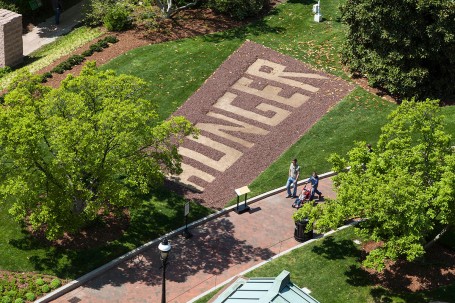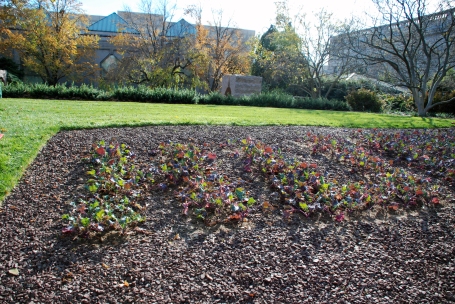Posts tagged ‘land art’
The Pyramid in the Garden

Ala
El Anatsui (1944- ), born in Ghana, based in Nigeria
Earthwork in “Earth Matters”
Site-specific, 2013
As part of its exhibition Earth Matters: Land as Material and Metaphor in the Arts of Africa, the National Museum of African Art invited several African artists to do earthworks in the Smithsonian’s gardens. These are large sculpture works which use earth as material, motif, and/or message. One of these is ”Ala” by Ghanaian artist El Anatsui.
Ala is the Igbo goddess of earth, and is also associated with morality, fertility, and creativity. Although she is usually depicted as a voluptuous woman, El Anatsui has chosen shape and materials to allude to her powers. The pyramidal shape may be seen as emblematic of the pyramids of Giza in Egypt. But for El Anatsui it reflects the ubiquity of mounds of earth in West Africa. There are termite mounds, and mounds may be used to mark the entrance of villages, serving as posts or guardians for those who live there. In addition, there are crops [e.g., yams] that are planted in mounds of earth.
The materials that sheath the pyramid are trade objects that come from the earth. The metal plates are graters made from flattened, repurposed large cans or drums. These are punctured with nails, leaving sharp ridges that are used for grating. These graters are used primarily for processing cassava, which is a staple food that was imported into Africa from Brazil. Cassava — also known by other names such as yuca, garri, manioc, and tapioca— is a very hardy and multi-purpose food which can be prepared in many forms: it can be boiled, fried, mashed into a paste, and ground into a flour-like substance. Depending on how it is cooked and used, cassava can be a main dish, a side dish, dessert, and even bread. Cassava has a long history as a trade object: it was carried on ships going from the western hemisphere to Africa and traded for human lives. It thus served as a kind of currency, with most of the cargo left in Africa. But enough was kept on board to feed those being taken as slaves to the Americas. Cassava therefore has a very mixed legacy: it was both the source of the slaves’ misery and the means of their survival and sustenance.
The graters are interspersed with mirrors, which comes from silica and therefore from sand. In more formal terms, mirrors break up the shape, giving what the artist calls ‘buoyancy’ or lightness to the structure. In addition to being trade objects, mirrors are used in transportation to reflect where we’ve come from. For El Anatsui, these mirrors are a visual pun: they allude to the sankofa bird, which twists its neck to look back and is associated with a variety of Asante proverbs and meanings, including the following:
(1) It is never too late to turn around and start on a new path once one has recognized one’s mistake.
(2) Look at your past and you will recognize your future.
(3) You don’t know where you’re going unless you know where you’ve come from.
Combining different shapes, media, history, and metaphors, El Anatsui has created a tribute to Ala which brings her ‘down to earth’ and makes her accessible to many in a variety of ways.
–Annette B. Ramírez de Arellano, Smithsonian docent
December 10, 2013 at 8:30 am smithsoniangardens Leave a comment
“Hunger” Amidst Plenty
Hunger
Ghada Amer, (1963 – ), born in Egypt, based in New York
Earthwork in “Earth Matters”
Site-specific, 2013
Ghada Amer is one of a selected number of artists invited by the National Museum of African Art to take part in the exhibit Earth Matters: Land as Material and Metaphor by creating an earthwork in the Smithsonian’s gardens. Earthworks are large sculptural works which use earth as material, motif, and/or message. Several of these earthworks have been installed in the Enid A. Haupt Garden in the vicinity of the Sackler and African Art Museums.
Amer works in a variety of genres: painting, sculpture, film, photography, installation. In much of her work she has appropriated two media that are usually associated with domestic arts or “women’s work”: embroidery and gardening. She therefore uses thread and plants to express messages that are highly political, focusing on a range of themes, including gender roles, women’s sexuality, and human rights. In the work currently on display in the Smithsonian Gardens, Amer has chosen the subject of hunger as her topic. She thus highlights a worldwide problem at the same time that she alludes to a specific issue: the fact that politicians in her native Egypt and elsewhere prey on the hungry by promising food in exchange for votes. Bags of rice and other edibles are therefore bartered for political support.
The current earthwork began with the delineation of large letters spelling the word “Hunger” along a strip of land at the north entrance of the Haupt Garden. Once the letters were outlined as furrows, they were planted with rice. The work has therefore evolved through different stages, reflecting the initial carving of the land and the growth of the ‘crops’ growing in the designated space.
Initially, the viewer could read the word “hunger” spelled out in earth. Then, the stenciled letters were filled in with small tufts of rice plants. Over the summer months, the plants grew very noticeably, and the edible rice began to emerge. This in turn attracted birds, who saw the grain as a bonus meal. As the plants grew and became bushier, the word was ‘hunger’ became less readable. The letters re-emerged once the crop was harvested. In keeping with the original idea of crop rotation, the letters will be planted with kale, which can survive colder temperatures. During fall and winter, the letters will become greener and denser.
In “Hunger,” as in some of her other work, Amer combines medium and message, and urges us to read both the ‘writing on the wall’ and the letters on the earth.
-Annette B. Ramírez de Arellano, Smithsonian volunteer
Earth Works at the Smithsonian
This post was originally published on the National Museum of African Art Earth Matters blog.
The post today features Jonathan Kavalier, a supervisory horticulturist with Smithsonian Gardens, who was integral in making the Earth Works happen in conjunction with the Earth Matters exhibit. This partnership marks a first for the Smithsonian – never before has land art been installed on the National Mall. Learn about the process of making this amazing feat happen– with 30 million visitors to the nation’s capital looking on.

Strijdom van der Merwe’s piece, Land Reform, on Independence Ave. in Washington, DC – photo courtesy Jonathan Kavalier
As a horticulturist, I don’t often have the opportunity to participate in art exhibitions. So when museum curator Karen Milbourne approached me with an idea for a collaboration between the National Museum of African Art (NMAfA) and Smithsonian Gardens, my interest was piqued. I met Karen when she attended a talk I gave on building gardens in Madagascar, a country I had the immense pleasure of living in for two years before joining the Smithsonian. Since I was already emotionally invested in Africa, the idea of collaborating with NMAfA sounded great, and definitely supported Smithsonian Gardens’ mission to enrich the Smithsonian experience through exceptional gardens, horticultural exhibits, collections, and education. What came out of many discussions was an idea to commission earthworks from several African artists in some of the Smithsonian Gardens.

Ledelle Moe’s outdoor sculpture piece, Land/Displacements, outside the National Museum of African Art – photo via Pinterest
Now two years later, this idea has finally come to fruition. My job was to manage the logistics of installing these very different earth works involving sculpture, living plants, and earth moving. Add to that the challenge of working around existing garden infrastructure and the 30 million visitors that come through the Smithsonian annually, all without compromising the artists’ visions. I am very happy to say that the earth works have all been successfully installed, and some rice planting finally happened a few weeks ago for Ghada Amer’s piece, Hunger. We’ve actually been growing rice in our greenhouses for the past two months, eagerly waiting for the warmer weather to arrive so we can plant the rice into the Earth Works exhibit.
The most challenging, and rewarding, part of coordinating these installations was working around the visiting public during what is the busiest time of year for Smithsonian Gardens. Lots of time and effort were put into ensuring the public’s safety during the course of the work, but the reward of observing visitors witnessing the creation of these exhibits was priceless.

Looking down Independence Ave. along the folds of van der Merwe’s Land Reform – photo courtesy Jonathan Kavalier
We hope you’ll stop by the National Mall this summer and fall and see these spectacular works of art that only could have happened with the partnership and hard work of Jonathan Kavalier and the rest of Smithsonian Gardens. They mark a true “first” for the Smithsonian, revealing the constant connection between art, humanity, and the land that each earth artist in the show has skillfully and distinctly revealed. Don’t miss it!



